AutoZone Bundle
How Did AutoZone Drive Its Way to the Top?
Ever wondered how a single auto parts store transformed into an industry giant? AutoZone's story is a compelling journey of innovation and strategic growth. From its inception in 1979 as Auto Shack, the company's commitment to customer service and extensive inventory has been a driving force. This brief history unveils the key moments that shaped AutoZone's remarkable rise.
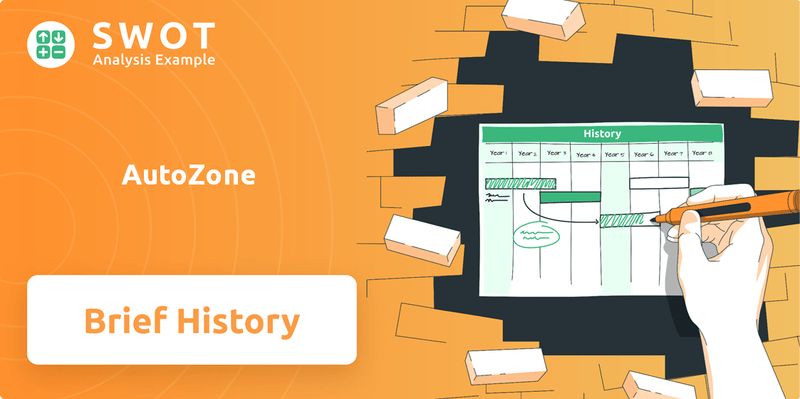
Tracing the AutoZone SWOT Analysis reveals the company's strategic evolution. Understanding the AutoZone history means examining its early years and recognizing the vision of the AutoZone founder. With over 7,000 AutoZone stores across multiple countries as of early 2024, the AutoZone company continues to dominate the Auto parts retailer landscape, a testament to its enduring business model and ability to adapt to market changes.
What is the AutoZone Founding Story?
The AutoZone company story began on July 4, 1979, when J.R. Hyde III founded the company, initially named Auto Shack. This marked the inception of what would become a leading auto parts retailer. Hyde's vision was to revolutionize the auto parts retail experience, offering a customer-centric approach.
Hyde identified a gap in the market for a convenient and comprehensive source of automotive parts, setting the stage for Auto Shack's initial business model. The company aimed to provide a broad selection of quality auto parts and accessories in a well-organized retail environment. The early product offerings included a wide array of replacement parts, fluids, and accessories for various vehicles.
The name changed to AutoZone in 1987, reflecting a broader brand identity as the company expanded. Initial funding came from J.R. Hyde III's background, likely involving personal capital and strategic investments. The late 1970s, with its growing DIY culture and increasing vehicle ownership, created a favorable environment for Auto Shack's customer-focused strategy.
AutoZone's early years were marked by a focus on establishing a strong retail presence and customer service.
- The company's early focus was on offering a wide selection of auto parts and accessories.
- AutoZone aimed to provide a clean, organized retail environment.
- Knowledgeable employees were a key part of the customer service strategy.
- The company's initial growth was fueled by a customer-centric approach.
AutoZone SWOT Analysis
- Complete SWOT Breakdown
- Fully Customizable
- Editable in Excel & Word
- Professional Formatting
- Investor-Ready Format
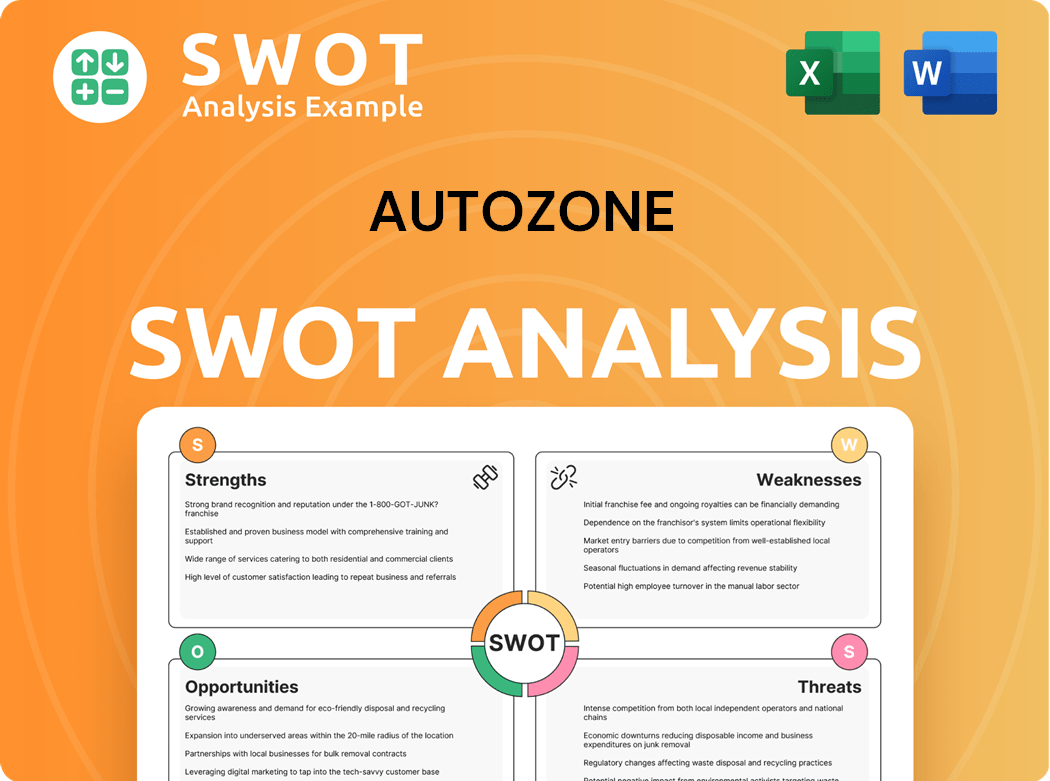
What Drove the Early Growth of AutoZone?
The early growth and expansion of the company, marked by its founding, saw a strategic increase in store locations and a strong focus on improving customer experience. The company's journey began as Auto Shack in 1979, with rapid store openings, mainly in the Southern United States. This period was crucial for establishing a strong foundation in the auto parts retail sector. The company's early years were characterized by innovative strategies and a customer-centric approach, setting the stage for future growth.
A key move was the introduction of the WITT-JR inventory management system in 1980, which was critical for optimizing inventory and ensuring product availability. This early adoption of technology gave the company a competitive advantage in the auto parts retailer market. In 1987, the company rebranded to AutoZone, signaling a more ambitious vision. This era also saw the introduction of the 'Loan-A-Tool' program, a customer-focused service that allowed borrowing specialized tools.
By 1996, the company had opened its 1,300th store, marking a significant milestone in its expansion history. The company's growth strategy included both organic expansion and strategic acquisitions. The acquisition of Chief Auto Parts in 1998 added 565 stores, particularly boosting its presence in the Western U.S. This was a pivotal move in the company's expansion, increasing its footprint significantly.
In 1998, the company launched AutoZone.com, entering the e-commerce space and adapting to the evolving retail landscape. The company's entry into e-commerce was a strategic move to cater to changing consumer behaviors. Leadership transitions during this period included John C. Adams becoming CEO in 1996, who continued to lead the company through its rapid expansion. The company's ability to adapt and innovate has been key to its success.
The market responded positively to the company's model, which combined a wide product selection with strong customer service. This approach resonated with DIY enthusiasts and professional mechanics. This strategy allowed the company to effectively challenge smaller, independent auto parts stores. For more insights into the company's business model, consider reading about Revenue Streams & Business Model of AutoZone.
AutoZone PESTLE Analysis
- Covers All 6 PESTLE Categories
- No Research Needed – Save Hours of Work
- Built by Experts, Trusted by Consultants
- Instant Download, Ready to Use
- 100% Editable, Fully Customizable
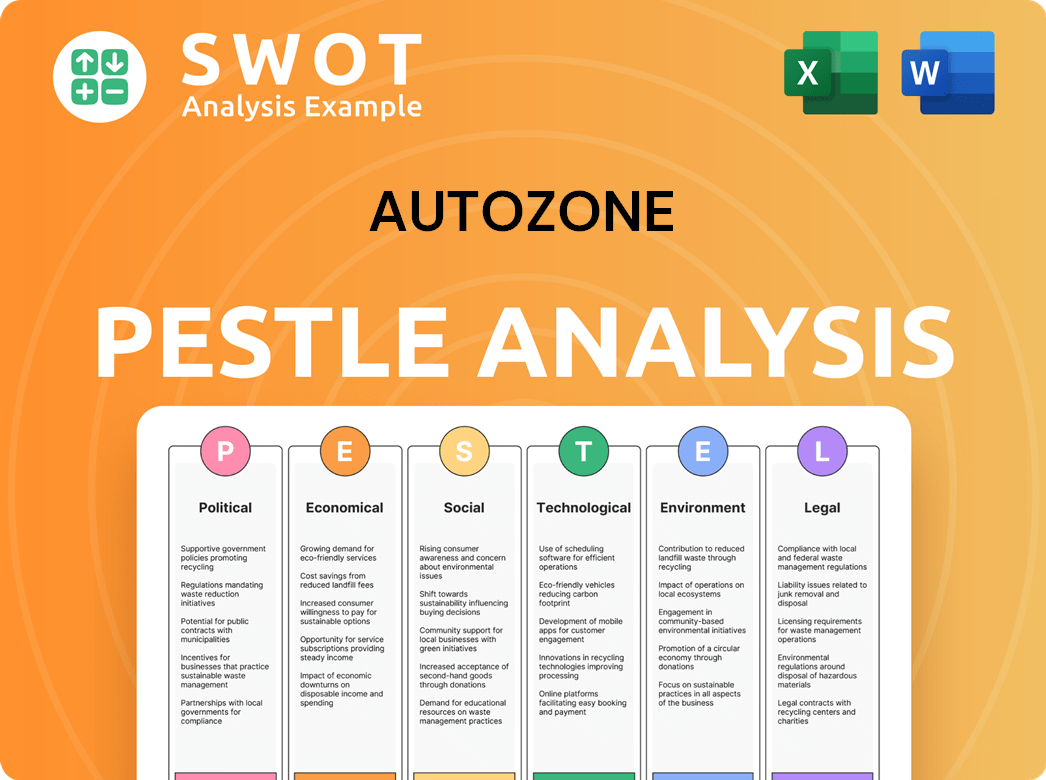
What are the key Milestones in AutoZone history?
The Owners & Shareholders of AutoZone have witnessed a remarkable journey marked by strategic growth and significant milestones. From its inception, the company has expanded its footprint and service offerings, establishing itself as a leader in the auto parts industry. This expansion has been crucial to its success.
| Year | Milestone |
|---|---|
| 1979 | AutoZone was founded, marking the beginning of its journey as an auto parts retailer. |
| 1980 | The company introduced WITT-JR, a proprietary inventory management system, to optimize stock. |
| 1987 | The 'Loan-A-Tool' program was launched, providing customers access to specialized tools. |
| 1996 | AutoZone reached the milestone of 1,000 stores and began offering free diagnostic services. |
| 1998 | The company launched AutoZone.com and entered the Mexican market. |
| 2012 | AutoZone expanded its international presence by entering Brazil. |
| 2024 | By early 2024, AutoZone surpassed 7,000 stores across North and South America. |
Innovation has been a cornerstone of AutoZone's strategy, driving its competitive advantage and customer service. These innovations have helped the company adapt to the changing needs of the automotive industry.
In 1980, AutoZone introduced WITT-JR, a proprietary inventory management system. This system optimized stock levels and ensured product availability, giving the company a significant edge in the auto parts market.
Launched in 1987, the 'Loan-A-Tool' program allowed customers to borrow specialized tools. This initiative enhanced DIY capabilities and customer satisfaction, setting AutoZone apart from competitors.
In 1996, AutoZone began offering free diagnostic services for check engine lights. This service improved customer support and helped build loyalty, providing valuable insights for vehicle maintenance.
The launch of AutoZone.com in 1998 expanded the company's reach. This move helped the company to adapt to the growing trend of online shopping, increasing accessibility for customers.
The AutoZone company has faced various challenges, but it has consistently adapted to maintain its market position. These challenges have pushed the company to innovate and refine its strategies.
Economic downturns have presented challenges to the retail sector, impacting consumer spending. AutoZone has navigated these periods through strategic cost management and operational efficiencies.
Competition from traditional auto parts retailers and online competitors has increased. AutoZone has responded by expanding its e-commerce capabilities and enhancing customer service.
The increasing complexity of vehicle technology has required continuous adaptation in inventory and employee training. AutoZone has invested in training programs to ensure its staff can support customers.
Market fluctuations have influenced demand for auto parts. AutoZone has focused on operational efficiency and a diversified product offering to mitigate these impacts.
AutoZone Business Model Canvas
- Complete 9-Block Business Model Canvas
- Effortlessly Communicate Your Business Strategy
- Investor-Ready BMC Format
- 100% Editable and Customizable
- Clear and Structured Layout
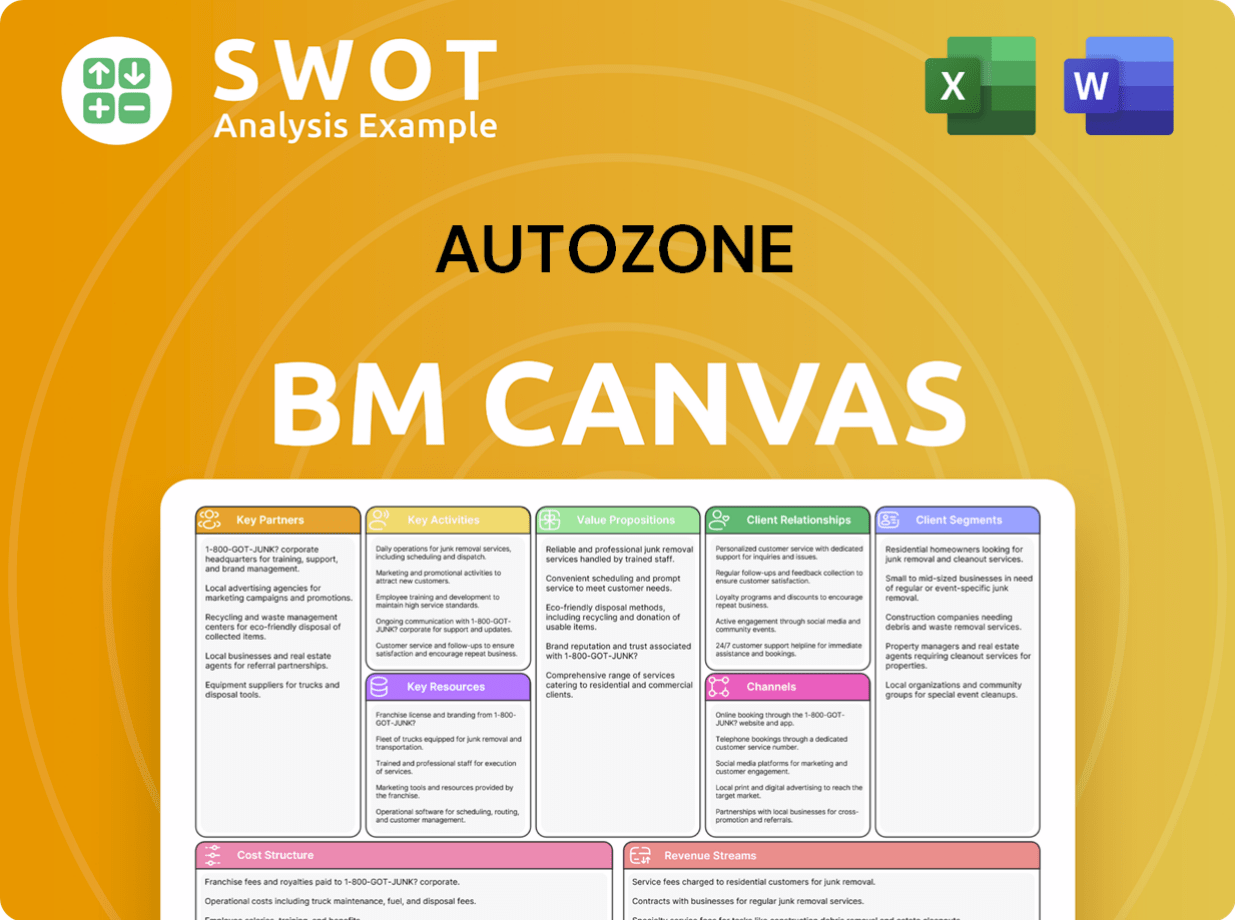
What is the Timeline of Key Events for AutoZone?
The AutoZone company has a rich history, marked by strategic decisions and expansions that have solidified its position as a leading auto parts retailer. Founded by J.R. Hyde III, the company's evolution reflects its commitment to innovation and customer service.
| Year | Key Event |
|---|---|
| 1979 | Founded as Auto Shack in Forrest City, Arkansas by J.R. Hyde III. |
| 1980 | Implemented the WITT-JR inventory management system. |
| 1987 | Rebranded from Auto Shack to AutoZone. |
| 1987 | Introduced the 'Loan-A-Tool' program. |
| 1996 | Opened its 1,000th store and launched diagnostic services. |
| 1998 | Acquired Chief Auto Parts, adding 565 stores, and launched AutoZone.com. |
| 1998 | Expanded internationally into Mexico. |
| 2012 | Expanded into Brazil. |
| 2024 | Operates over 7,000 stores across the U.S., Mexico, and Brazil. |
The company is focused on expanding its store footprint, particularly in international markets like Mexico and Brazil. These regions offer significant opportunities for market penetration, with plans to open more stores in the coming years. This strategy aligns with the company's goal of increasing its global presence and catering to a wider customer base.
The company is enhancing its digital presence and e-commerce capabilities to meet evolving customer needs. This includes optimizing its website and mobile app to provide a seamless omnichannel experience for both DIY customers and professional repair shops. Investments in technology will improve customer service and streamline operations.
The increasing average age of vehicles on the road and the growing complexity of vehicle technology will impact the company. The company is adapting its product offerings and employee training to meet the needs of electric vehicles (EVs) and advanced driver-assistance systems (ADAS). This proactive approach ensures the company remains relevant.
Analyst predictions generally remain positive for the company, citing its strong market position and consistent financial performance. The company’s leadership emphasizes a continued commitment to customer service, technological innovation, and strategic market expansion. This forward-looking approach supports long-term growth and value creation.
AutoZone Porter's Five Forces Analysis
- Covers All 5 Competitive Forces in Detail
- Structured for Consultants, Students, and Founders
- 100% Editable in Microsoft Word & Excel
- Instant Digital Download – Use Immediately
- Compatible with Mac & PC – Fully Unlocked
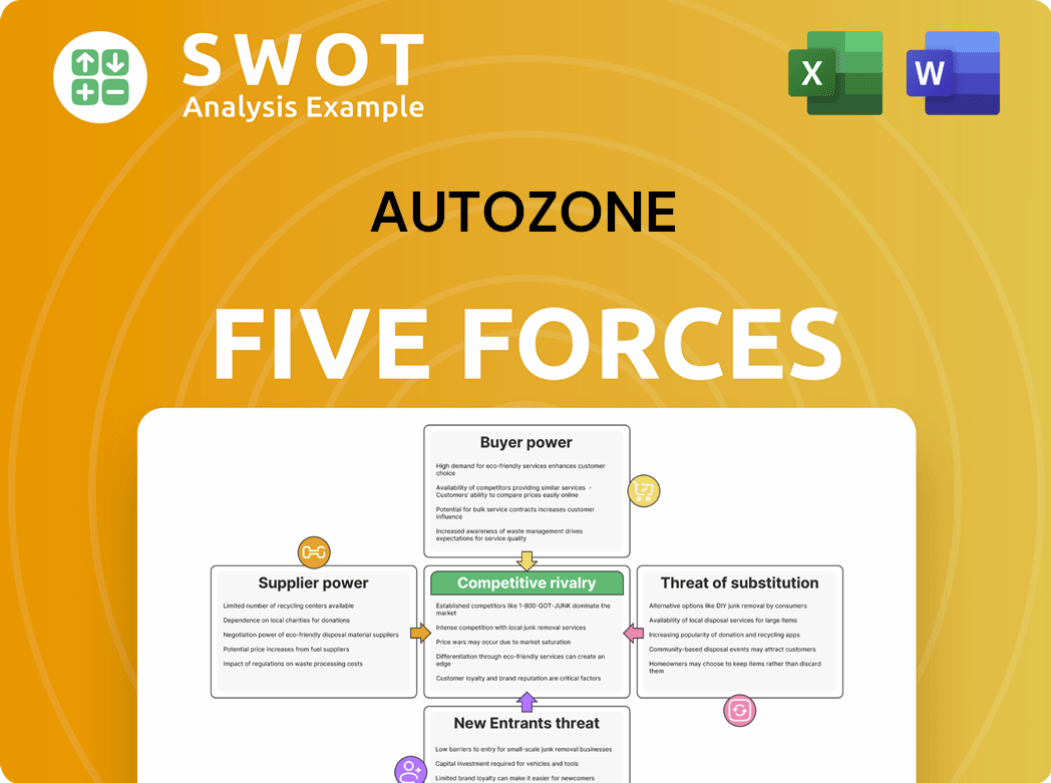
Related Blogs
- What is Competitive Landscape of AutoZone Company?
- What is Growth Strategy and Future Prospects of AutoZone Company?
- How Does AutoZone Company Work?
- What is Sales and Marketing Strategy of AutoZone Company?
- What is Brief History of AutoZone Company?
- Who Owns AutoZone Company?
- What is Customer Demographics and Target Market of AutoZone Company?
Disclaimer
All information, articles, and product details provided on this website are for general informational and educational purposes only. We do not claim any ownership over, nor do we intend to infringe upon, any trademarks, copyrights, logos, brand names, or other intellectual property mentioned or depicted on this site. Such intellectual property remains the property of its respective owners, and any references here are made solely for identification or informational purposes, without implying any affiliation, endorsement, or partnership.
We make no representations or warranties, express or implied, regarding the accuracy, completeness, or suitability of any content or products presented. Nothing on this website should be construed as legal, tax, investment, financial, medical, or other professional advice. In addition, no part of this site—including articles or product references—constitutes a solicitation, recommendation, endorsement, advertisement, or offer to buy or sell any securities, franchises, or other financial instruments, particularly in jurisdictions where such activity would be unlawful.
All content is of a general nature and may not address the specific circumstances of any individual or entity. It is not a substitute for professional advice or services. Any actions you take based on the information provided here are strictly at your own risk. You accept full responsibility for any decisions or outcomes arising from your use of this website and agree to release us from any liability in connection with your use of, or reliance upon, the content or products found herein.